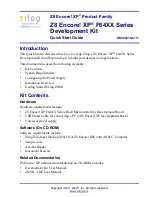DR
AFT
DR
AFT
DRAFT
DR
D
RAFT
DRAFT
DRA
FT DRAF
D
RAFT DRAFT DRAFT DRAFT DRAFT D
DRAFT
D
RAFT DRA
FT DRAFT DRAFT DRAFT DRA
UM10316_0
© NXP B.V. 2008. All rights reserved.
User manual
Rev. 00.06 — 17 December 2008
293 of 571
NXP Semiconductors
UM10316
Chapter 19: LPC29xx Universal Asynchronous Receiver/Transmitter
While the receiver is ENABLED (RS485CTRL bit 1 = ‘0’) all bytes received will be
accepted and stored in the RXFIFO until an address byte which does not match the
RS485ADRMATCH value is received. When this occurs, the receiver will be automatically
disabled in hardware (RS485CTRL bit 1 will be set), The received non-matching address
character will not be stored in the RXFIFO.
RS-485/EIA-485 Auto Direction Control
RS485/EIA-485 Mode includes the option of allowing the transmitter to automatically
control the state of either the RTS pin or the DTR pin as a direction control output signal.
Setting RS485CTRL bit 4 = ‘1’ enables this feature.
Direction control, if enabled, will use the RTS pin when RS485CTRL bit 3 = ‘0’. It will use
the DTR pin when RS485CTRL bit 3 = ‘1’.
When Auto Direction Control is enabled, the selected pin will be asserted (driven low)
when the CPU writes data into the TXFIFO. The pin will be de-asserted (driven high) once
the last bit of data has been transmitted. See bits 4 and 5 in the RS485CTRL register.
The RS485CTRL bit 4 takes precedence over all other mechanisms controlling RTS (or
DTR) with the exception of loopback mode.
RS485/EIA-485 driver delay time
The driver delay time is the delay between the last stop bit leaving the TXFIFO and the
de-assertion of RTS (or DTR). This delay time can be programmed in the 8-bit RS485DLY
register. The delay time is in periods of the baud clock. Any delay time from 0 to 255 bit
times may be programmed.
RS485/EIA-485 output inversion
The polarity of the direction control signal on the RTS (or DTR) pins can be reversed by
programming bit 5 in the U1RS485CTRL register. When this bit is set, the direction control
pin will be driven to logic 1 when the transmitter has data waiting to be sent. The direction
control pin will be driven to logic 0 after the last bit of data has been transmitted.
5.
Architecture
The architecture of the UARTs 0, 1 are shown below in the block diagram.
The APB interface provides a communications link between the CPU or host and the
UART.
The UARTn receiver block, UnRX, monitors the serial input line, RXDn, for valid input.
The UARTn RX Shift Register (UnRSR) accepts valid characters via RXDn. After a valid
character is assembled in the UnRSR, it is passed to the UARTn RX Buffer Register FIFO
to await access by the CPU or host via the generic host interface.
The UARTn transmitter block, UnTX, accepts data written by the CPU or host and buffers
the data in the UARTn TX Holding Register FIFO (UnTHR). The UARTn TX Shift Register
(UnTSR) reads the data stored in the UnTHR and assembles the data to transmit via the
serial output pin, TXDn.


















